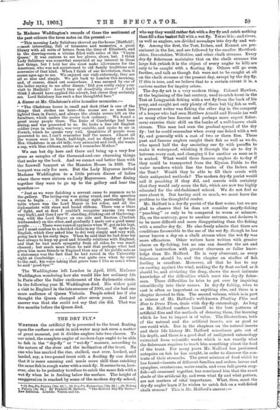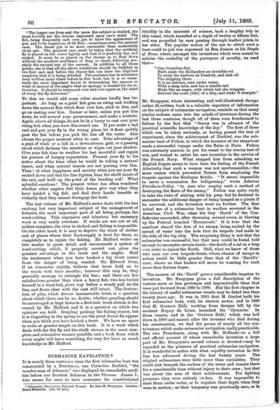THE DRY FLY.*
WHETHER the artificial fly is presented to the trout floating upon the surface or sunk in mid-water may not seem a matter of great moment, yet it divides anglers into two classes. To our mind, the complete angler of modern days ought to be able to fish in the " dry-fly " or " wet-fly " manner, according to the nature of the river and the inclination of the trout. No one who has marked the rise, stalked, cast over, booked, and landed, say, a two-pound trout with a floating fly can doubt that it is more amusing and needs more skill than catching the same fish in rough water with a sunk fly. It seems to us, how- ever, also to be pedantry to refuse to catch the same fish with a wet fly when he is feeding below the surface. The height of exaggeration is reached by some of the modern dry-fly school, • (1) Dry•Flv Fishing [10s. 6d.]; (2) Dry-F1, Entomology n2s. 6d.] ,• (3) Making a Fish.ery [3s. 6d.] By Frederic IL Raiford. " The Milford Dry-Fly Series." New Editions. London: Vinton and Co. who say they would rather fish with a dry fly and catch nothing than fill a fine basket full with a wet fly. Yet so it is ; and rivers, as well as anglers, are divided nowadays into dry-fly and wet- fly. Among the first, the Test, Itchen, and Kennet are pre- eminent in the list, and are followed by the smaller Hertford- shire, Dorsetshire, Wiltshire, and other chalk streams. Every dry-fly fisherman maintains that on the chalk streams the large fish (which it is the object of every angler to kill) are only to be caught with ,a floating fly. Others will go even further, and talk as though fish were not to be caught at all on the chalk streams at the present day, except by the dry fly. If this is true, and we believe that to a certain extent it is, a curious matter for inquiry arises.
The dry-fly art is a very modern thing. Colonel Hawker, at the beginning of the last century, used to catch trout in the Test at Longparish fishing with a wet fly from the back of his pony, and caught not only plenty of them but big fish as well. The present writer was fishing the other day in the company of a keeper who had seen Matthew Arnold and Fronde (as well as many other less famous and perhaps more expert fisher- men) exercise their skill on the banks of a well-known chalk stream. This man had seen the gradual spread of the dry fly: but he could remember when every one fished with a wet fly, and generally with a cast of two or three flies. These past and famous anglers caught their fish as well as we do, who spend half the day anointing our fly with paraffin to make it waterproof, whisking it through the air to dry it between every cast, and changing it for another as soon as it is soaked. What would these famous anglers do to-day if they could be transported from the Elysian Fields to the water meadows which line the banks of the Itchen and the Test? Would they be able to fill their creels with their antiquated methods ? The modern dry-fly purist would call it poaching if they did, and asserts with certainty that they would only scare the fish, which are now too highly educated for the old-fashioned school. We do not feel so sure about it. But having said so much, we must leave the problem to the thoughtful reader.
Mr. Halford is a dry-fly purist of the first water, but we are glad to observe that he does not consider mayfly-fishing "poaching" or only to be compared to worm or minnow. He, on the contrary, goes to another extreme, and declares it to be more difficult and more disappointing than the fishing with a smaller dry fly. He also freely admits that there are conditions favourable to the use of the wet fly, though he has never known a day on a chalk stream when the wet fly was more efficacious. Other writers have written with greater charm on fly-fishing, but no one can describe the art and impart instruction with greater clearness or fuller know- ledge than Mr. Halford. He is very observant, as every fisherman should be, and the chapter on studies of fish feeding is excellent. Moreover, all that he has to say on casting against the wind, making the fly float cocked as it should be, and obviating the drag, shows the most intimate knowledge of the difficulties which meet the dry-fly fisher- man. These difficulties he tries to get over by inquiring scientifically into their causes. In dry-fly fishing, when to cast is often as important as anything else, and there is a chapter devoted to this. The second volume, which is in part a reissue of Mr. Halford's well-known Floating Flies and How to Dress Them, deals with dry-fly entomology. As long as Mr. Halford confines himself to the best patterns of artificial flies and the methods of dressing them, the learning
which be has to impart is of value. The illustrations, both of the natural and the artificial insects, are as good as one could wish. But in the chapters on the natural insects and their life history Mr. Halford sometimes gets out of his depth, and there is a good deal of undigested entomology
extracted from scientific works which is not exactly what
the fisherman requires to teach him something about the food of the trout. For many years Mr. Halford has performed autopsies on fish he has caught, in order to discover the con- tents of their stomachs. The great mixture of food which he has found—insects of different families and orders, larvae and nymphae, crustaceans, water-snails, and even full-grown cray- fish—all crammed together, has convinced him that the exact shade of the artificial fly, and even what fly and what pattern,
are not matters of vital importance. What, then, must the dry-fly angler learn if he wishes to catch fish on a well-fished chalk stream? This is Mr. Halford's answer :— "The longer one lives and -the more the subject is studied, the more forcibly are the lessons impressed upon one's mind. The fish, being frequently cast over, get to know the appearance of gut, and to be suspicious of all flies,--sometimes even the natural ones. • The finest gut is no more successful than moderately stout gut. The greatest care must be taken that the artificial fly is placed on the water lightly and that it is perfectly dry and cocked. It must be so placed on the stream as to float down without the smallest semblance of drag or check, followinc, pre- cisely the natural run of the current. In addition to all these points, one is that all the above conditions should be fulfilled in the first cast, and before the shyest fish can have the slightest suspicion that it is being deluded. This sentence has in substance been written many times before in this book, but it is so essen- tially the most important factor in determining the success or want of success of the angler that no apology is needed for its re- iteration. It should be impressed over and over again on the mind of every dry-fly fisherman."
To this we would add some other maxims hardly less im- portant. As long as a good fish goes on rising and sucking down the natural flies which float over him, stick to him, and go on casting over him. Sooner or later, unless you put him down, he will reward your perseverance, and make a mistake. Again, above all things, do not be in a hurry to cast over your rising fish when you have discovered one. If you make a bad cast and put your fly in the wrong place, let it float quietly past the fish before you pick the line off the water. Also choose the proper moment when to cast. Take advantage of a gust of wind, or a lull in a down-stream gale, or a passing
cloud which darkens the sunshine or wipes out your shadow. Give your fish time to swallow his last mouthful and regain his posture of hungry expectation. Present your fly to his notice about the time when he would be taking a natural insect, and when natural insects are not passing over him. Then ! oh what happiness and anxiety when you see your fly sucked down and feel the line tighten, hear the shrill music of the reel, and hold up the point of the bending rod! What splendid emotions ! The present writer has often wondered whether other anglers feel their knees give way when they have landed a big fish, and find their hands tremble so violently that they cannot disengage the hook.
The last volume of Mr. Halford's series deals with the less exciting but very important subject of the management of fisheries, the most important part of all being, perhaps, the weed-cutting. This expensive and laborious but necessary work is very easily overdone. If weeds are not cut at all, millers complain, the river is choked, and fishing is impossible. On the other hand, it is easy to deprive the trout of shelter and of places where their food-supply is bred for them, so completely as to injure the fishing. Mr. Halford writes on this • matter in great detail, and recommends a system of weed-cutting which, if properly carried out, gives the
greatest advantage to the trout and the angler. Half the excitement when you have hooked a big trout comes from the danger of being weeded. Sir Edward Grey, if we remember rightly, believes that trout hold on to the weeds with their mouths ; however this may be, they generally manage to entangle the line; and there are few satisfactions greater than when a heavy fish, who has buried himself in a weed-bed, gives way before a steady pull on the line, and floats clear with the cast still intact. The destruc- tion of pike, which devour innumerable trout, is a question about which there can be no doubt ; whether grayling should be encouraged or kept down in a first-rate trout stream is dis- cussed by Mr. Halford, and it is a question on which two opinions are held. Grayling prolong the fishing season, but it is disgusting in the spring to see the great dorsal fin appear when you think you have hooked a trout. We have no space to write at greater length on this book. It is a work which deals with the dry fly and the chalk stream in the most com- plete and exhaustive manner possible, and a book from which every angler will learn something, for very few have as much knowledge as Mr. Halford.







































 Previous page
Previous page